The Microsoft Surface Laptop 4 15-Inch Review: Refreshing Ryzen
by Brett Howse on May 6, 2021 8:00 AM ESTSystem Performance
The biggest change from the Surface Laptop 3 to the new Laptop 4 is what is under the hood. On the Intel front, Microsoft outfits the Surface Laptop 4 with the latest Intel 11th Gen Tiger Lake platform, with Core i5-1145G7 and Core i7-1185G7 options. Microsoft recommends these choices for customers needing the highest single-threaded performance, and they also offer them with the most memory at up to 32 GB. On the AMD front, Microsoft has expanded the AMD choices to include the 13.5-inch model this time, whereas for Surface Laptop 3, only the 15-inch model was offered with Ryzen. As already discussed, Microsoft has not gone with the latest and greatest Cezanne Ryzen platform for the Surface Laptop 4 but are instead using the Ryzen 4000 series Renoir APU from 2020.
There are a whole host of reasons why they would have chosen to go this route. With 2020 being the year that it was, it is very possible that they were planning on launching this in late 2020, but due to the pandemic globally, they were not able to hit that goal. Also, Microsoft has tagged AMD with providing “custom” processors for the Surface Laptop 4, which would likely be a supply issue when the chip is just coming off the fab. A more mature process, and lessons learned over the time manufacturing, would allow AMD to meet these demands easier than on day one of a new platform.
For the Surface Laptop 3, Microsoft designed semi-custom processors for their laptop, with the Microsoft Surface Edition Ryzen APUs being the fastest models available, and with an extra graphics unit for both the Ryzen 5 and Ryzen 7. This close partnership with AMD continues with the Surface Laptop 4, with semi-custom versions here as well. The extra graphics core only exists on the Ryzen 5 model though, bumping it to 7 graphics units from 6, whereas the Ryzen 7 model is just a frequency bump.
| Surface Laptop 4 Processors | |||||
| CPU | Intel Core i5-1145G7 | Intel Core i7-1185G7 | AMD Ryzen 5 4680U | AMD Ryzen 7 4980U | |
| CPU Core | Willow Cove | Willow Cove | Zen 2 | Zen 2 | |
| Cores / Threads | 4C / 8T | 4C / 8T | 6C / 12T | 8C / 16T | |
| GPU | Intel Iris Xe 80 Eus |
Intel Iris Xe 96 EUs |
Vega 7 | Vega 8 | |
| Base Frequency | 1.1 - 2.6 GHz | 1.2 - 3.2 GHz | 2.1 GHz | 2.0 GHz | |
| Max Boost Frequency | 4.4 GHz | 4.8 GHz | 4.0 GHz | 4.4 GHz | |
| Cache | 8 MB Smart Cache | 12 MB Smart Cache | 3 MB L2 / 8 MB L3 | 4 MB L2 / 8 MB L3 | |
| PCIe Version | 4.0 | 4.0 | 3.0 | 3.0 | |
| Process | Intel 10nm SuperFin | Intel 10nm SuperFin | TSMC 7nm | TSMC 7nm | |
The Surface Laptop 4, despite not using the Ryzen 5000 mobile platform, should still be a strong choice, with up to eight cores and sixteen threads in the Ryzen 7 4980U found in the review unit. It is a bit strange to not see memory parity with the Core i7 model though, as many potential AMD buyers will be put off by the lack of 32 GB memory support. Microsoft has expanded its Ryzen offerings and has more choices than ever, but is certainly holding it back somewhat with memory, and unlike storage, memory is not something that can be upgraded as it will be soldered in. The AMD powered Surface Laptop 4 offers double the cores, but only half the memory. It is a very odd pairing.
To see how the Surface Laptop 4 performs, it was run through our Laptop testing suite. If you would like to compare the Surface Laptop 4 against any other device we have tested, please use our Online Bench tool.
For comparison systems, both the Intel i7 and AMD Ryzen 7 models of the Surface Laptop 3 are included, as the obvious comparison point for the new generation. In addition, the Surface Book 3 is included, as it is the other 15-inch system from Microsoft, and includes a discrete GPU option. The Dell XPS 13 with Ice Lake is our newest version of the XPS 13 tested, although it has been updated to Tiger Lake since our review. For Tiger Lake, we have only tested the MSI Prestige 14 Evo so far, so that is included, and highlighted in blue, as a comparison against the best Intel has to offer, and what would be available in the Intel powered version of the Surface Laptop 4.
PCMark

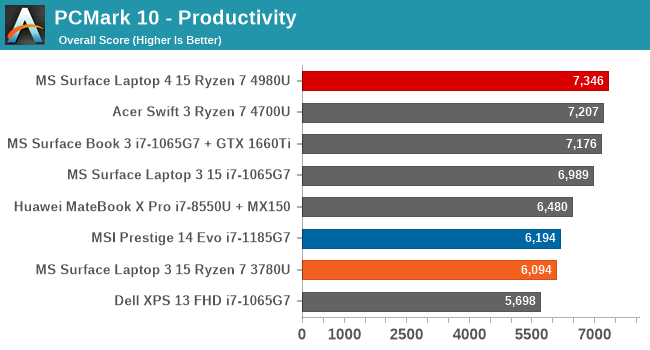
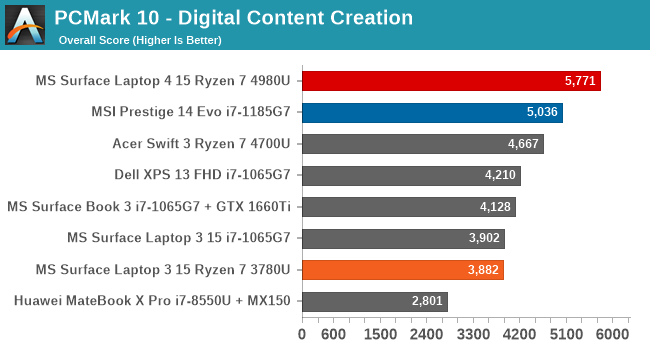
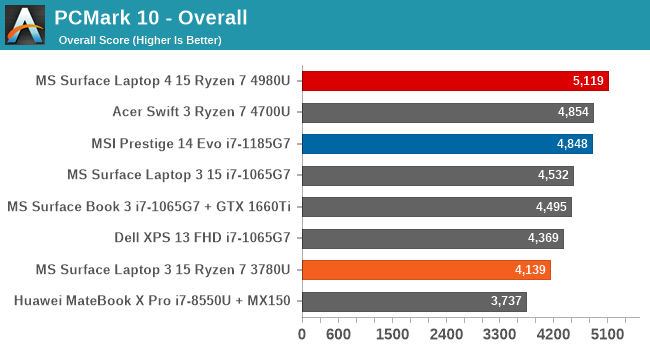
UL’s PCMark suite is a comprehensive set of tests which cover a wide range of workloads. They are broken into categories, and all components factor into the result, including CPU, GPU, memory, storage, and thermals. The Surface Laptop 4 performs very well. Having eight full cores with simultaneous multithreading available elevates the Surface Laptop 4 above the other notebooks tested. AMD’s Vega 8 graphics is also quite strong in the 15-Watt class.
Cinebench
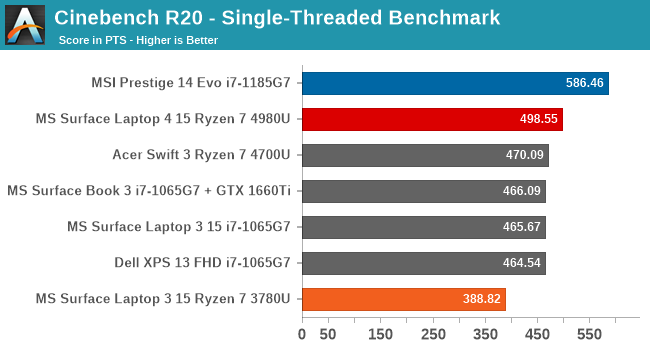
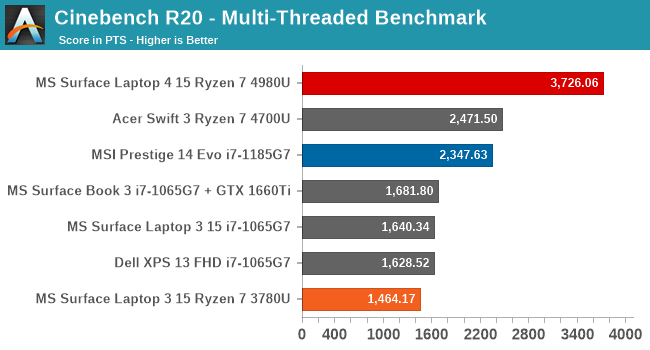
Cinebench is a purely CPU test, with both single-threaded and multi-threaded workloads. The single-threaded result shows just how far AMD has come since the Picasso platform of Surface Laptop 3, and the extra frequency headroom of the Microsoft Surface Edition bumps this device near the top. AMD, at least with the Zen 2 cores found inside of Renoir, is not quite at the same single-threaded performance of Intel’s Tiger Lake with its Willow Cove cores though, and the MSI Prestige is significantly ahead. Turn the tables to the multi-threaded results though, and AMD packing eight cores and sixteen threads onto this APU makes it dominant here. Remember though, Cinebench is not very memory dependent, and on more typical workloads, the extra cores and threads may not bring quite as large of an advantage.
Handbrake

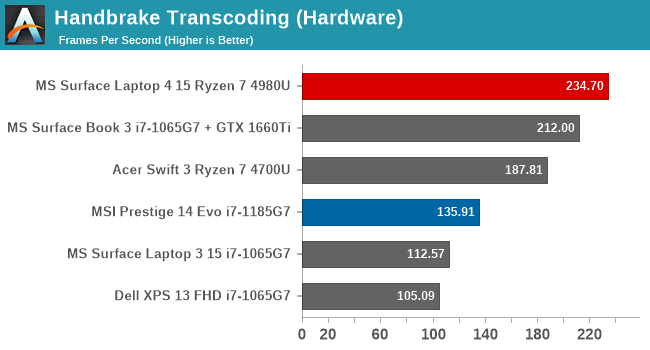
As one of the most popular video transcode tools, Handbrake makes an excellent real-world data point. With Handbrake, you can choose to do the transcode completely in software, which is 100% CPU based, or you can offload it to the video engine in the GPU. The general rule of thumb is that software-based transcoding provides the best results, but doing it in hardware is significantly quicker. On both fronts, the AMD powered Surface Laptop 4 is very speedy, and its extra cores and threads dominate the software encoding portion. Vega’s media engine also performs very well, and lands at the top. It even manages to outperform the NVIDIA encoder in the Surface Book 3, which is very impressive.
7-Zip
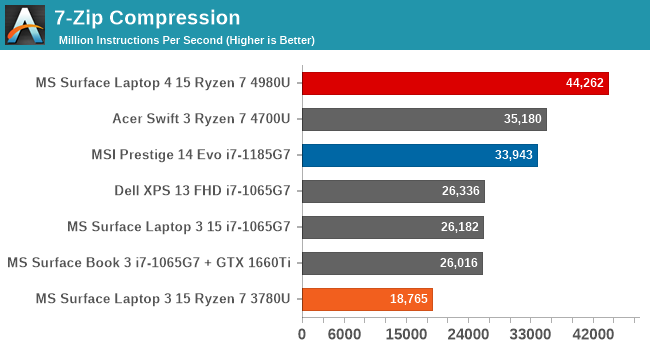
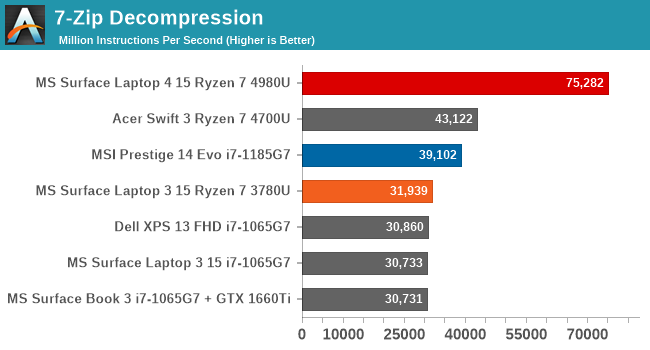
File compression and decompression is another common task on the PC, and for this we turn to the popular 7-Zip tool, which is open source, and includes a built-in benchmark. Once again, the extra Zen 2 cores dominate. The difference between the Surface Laptop 4, and the previous Surface Laptop 3 with Picasso, is enormous.
Web Performance
Web performance comes down to scripting performance, and unlike most other tests, the scripting engine in the browser plays a major role, so for consistency, this test uses the Microsoft Edge browser, which is now leveraging the Chromium engine under the covers. As always, browser performance evolves over time with updates, so these results, more than the previous ones, are more of a snapshot in time.
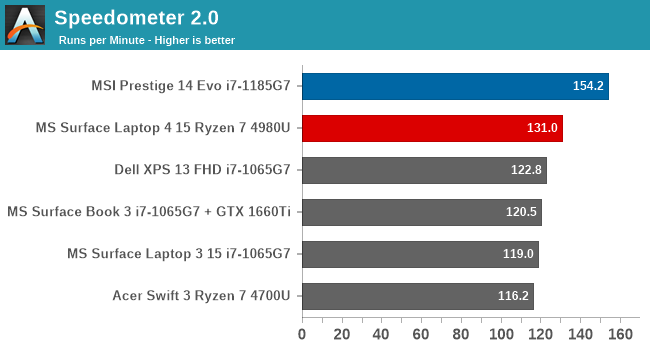

In Speedometer, Intel’s Tiger Lake platform, with its superior single-threaded performance, and Intel’s aggressive Speed Shift, is still the winner here, although the new, higher frequency Ryzen 7 4980U is able to surpass the Ice Lake laptops and slot into second place. WebXPRT is in a similar situation, but the Renoir platform still provides solid performance here.
Storage Performance
On the storage side, Microsoft has moved away from soldered BGA SSDs, back to more traditional M.2 designs, and this is to improve repairability, since the BGA designs could not be replaced. This is a good move for customers. It is still not simple to swap out the SSD, but it is at least possible. SSDs in notebooks are often from multiple vendors, and our review unit features a 512GB Samsung PM991. This is a PCIe 3.0 x4 design, and is a mid-level design in terms of performance, with a maximum rated read speed of 2200 MB/s, and write speeds of 1200 MB/s.
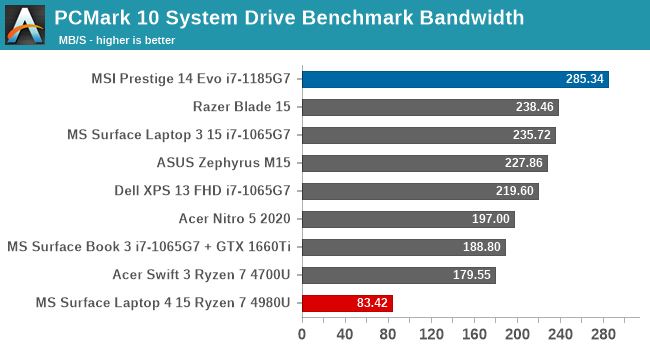

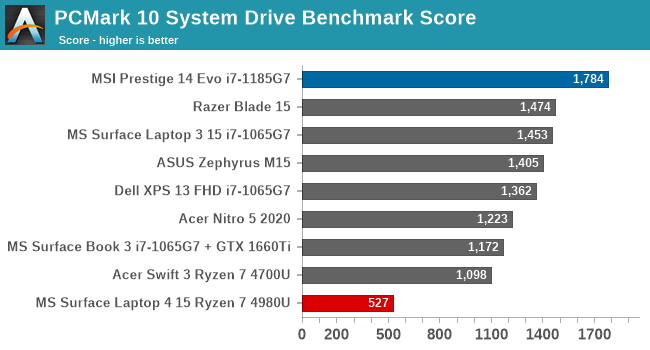
Unfortunately, the results in the Surface Laptop 4 were less than amazing. On peak, it can hit the rated speeds, but to more accurately see how this SSD performs, the PCMark 10 storage test is run, which uses real-world data traces, and runs for over an hour. Although this is the exact same SSD as found in the Acer Swift 3, and at the same capacity, performance was much lower.
Although the device does get warm during the test, the SSD only gets to about 52°C and the SMART controller does not indicate that the drive is throttling. So for reasons that are less than clear at the moment, the results above appear to be the best that the PM991 version of the Surface Laptop 4 can do.
To see if this was a one-off or not, I reached out to Daniel Rubino of Windows Central to see how his Surface Laptop 4 review unit performed. His model was slightly different and included a SK Hynix drive; nonetheless he got an overall score of 989, almost double our score. If ntohing else, this underscores the fact that SSDs are a commodity, and with the global chip shortage, it is not surprising to see the sourcing be from multiple vendors.










98 Comments
View All Comments
Reflex - Thursday, May 6, 2021 - link
This list is silly. Almost all of the things you mention are mostly accessed wirelessly these days. USB-A to USB-C adapters are super cheap and Anker sells a nice line of USB-C hubs that provide additional ports if you truly need them. I have one in my bag due to my Dell laptop having only 2 USB-C ports, but I can't even remember the last time I needed to use it.There are excellent actual bluetooth mice out there, I use a Microsoft one.
Who is using their optical drive on the go, or really at all?
Your storage is better in the cloud or on the network, again how most people use it nowadays.
Also, printers, can you even buy a decent printer that isn't wireless now?
And again, bluetooth keyboards are a thing and they are cheap.
Just bizarre list. Reads like someone stuck in computing from 15 years ago.
If this is your list of needs, modern ultrabooks are not for you.
Kevin G - Thursday, May 6, 2021 - link
Or people reasonably can't afford to repurchase everything. A cheap just to get it done wired mouse can be had for as little as $5 where as a good BlueTooth mouse starts at $20. The kicker is that people already have a wired mouse they could plug-in and use. Yeah, $20 in the grand scheme of things but when you have pay that extra amount five or six times, it starts to get noticed by the masses especially on top of the price of a new ultrabook.Ditto for printers. If you've saved up and purchased a unit years ago and is humming along nicely, why replace it with something new? At some point it does make sense to upgrade due to the lack of ink/toner available on the market or it just breaks down, but realistically things can last a very long time.
My Dell 5540M I'm currently using has two USB-A and one TB3 port and I often find myself limited. I use a lot of hardwired networking to isolated networks so there goes one port dedicated to that. The wired networking port generally gets the TB port even though it is type-A and I'll need an A-to-C adapter. One Type A goes to a wired mouse since it also doubles as a mouse for some systems that either have BT disabled or no wireless connectivity at all (and i'm not going to carry a second one if i don't have to). The remaining type A is often used for removable storage or a wired audio device. Thankfully I still have a dedicated barrel power jack. The TB3 port also supports power in a pinch and I borrowed other people's type-c chargers in an emergency. There are indeed times where I wish I had four USB ports.
I also do have access to a USB external optical drive which I pull out once or twice year to access an old physical media file. I've probably had this over half a decade with the same relative pace of usage and probably will keep on to it until it break at what point I imagine it'll pass the decade mark. My coworkers know I have it and again a few times a year one will ask to borrow it for a similar one-off data transfer. Migrating data to the network/cloud is a generally a good idea but it takes time, has costs (and monthly costs for the cloud) associated for it and a small amount of skill on the user's end.
simonpschmitt - Friday, May 7, 2021 - link
While your desccribed use case seems to need more (USB) ports at times most of it could be managed by a cheap USB-hub.Additionally, you must admit that this is beyond propably 99% of computer users out there.
Most people don't use one mouse for more than one computer.
Actually everyone I know outside IT does not use wired networking on a mobile device.
For my sisters (both teachers) and parents (small buisness owners) switching everything possible to wireless was propably the best quality of live upgrade since they use computers.
Kevin G - Monday, May 10, 2021 - link
Hubs can be problematic vs. having the port natively in a device. Large capacity hubs or those that can power other devices require AC outlets. Small data only hubs exist but generally are not the highest quality. Hubs also run the risk of some one tripping over a cable and unplugging everything off of that hub (uplink is disconnected) vs. a single device. A single home run to the host device is strongly preferred where every possible. This also applies to various adapters from say USB-C to DisplayPort: a single cable with the proper ends is preferred over a USB-C to female DP port and a DP-to-DP cable. Simply less to go wrong in the single path and you carry around less.Wired networking is critical for me as I often work on isolated, wired networks. There have been at times where I've been on two independent wired networks and still had wi-fi going. I realize that my use-case is rather specific but it does drive home the more general idea that the number of USB ports on a system is restrictively small, especially if they're pulling double duty for the likes of power, video, audio and networking.
PaulMack - Thursday, May 6, 2021 - link
I've had a Surface for some time and, while the limitation to one USB port is occasionally annoying, it's never been for a mouse. It's a premium device, and it's not unreasonable to spend $/£/€50 on a Bluetooth mouse. I only ever hit the limit when connecting a memory stick and another peripheral, and that's rare when on the move without the dock.MrCommunistGen - Thursday, May 6, 2021 - link
You can get a pretty inexpensive travel USB-A 3.0 hub for less than $20. I just keep one in my travel bag. A quick search turned up two different 4-port models for $13-15.yankeeDDL - Friday, May 7, 2021 - link
By "expensive adapter" you mean something like this (25usd)? https://www.amazon.com/-/es/Adaptador-USB-Hub-Mult...Using more than 2 USB port at the time is quite rare. Yes, more ports would help, but clearly teh space is rather limited.
Spunjji - Friday, May 7, 2021 - link
If you're using an external optical drive and a printer then you can probably handle using a hub, too.29a - Friday, May 7, 2021 - link
People giving presentations often need more than one USB port which I can see this laptop being used to give a lot of presentations. A flash drive and a Powerpoint presenter are both commonly used when giving presentations, that's two USB ports there.philehidiot - Sunday, May 9, 2021 - link
Typical use case for a business machine - running software that requires a USB dongle to operate. Removing it disables the software. One port down. Need to charge? Both down. How about people who leave a low profile USB drive in a slot for local back up purposes? If my livelihood is based on what is on that machine, I've got a local backup running as well as cloud.Sure, plug in a USB C dongle with a wire and giant block with all the connections you'll need (because having a different one for every use is expensive and fiddly) and you'd better not be using the laptop on your lap on a train or in a car. It'll dangle off your lap, yanking on the port constantly.
A business laptop, in my humble opinion, should have three available ports as a minimum. But as others have said here, they are likely working on feedback from telemetry and real world use. 95% of people don't use it so screw 5%.
In my view, a business laptop like this, with such an asking price should be putting in the extras that ensure more than the bare minimum for the majority. The people who have a use case as I have suggested above simply won't buy it, so it won't be their problem.